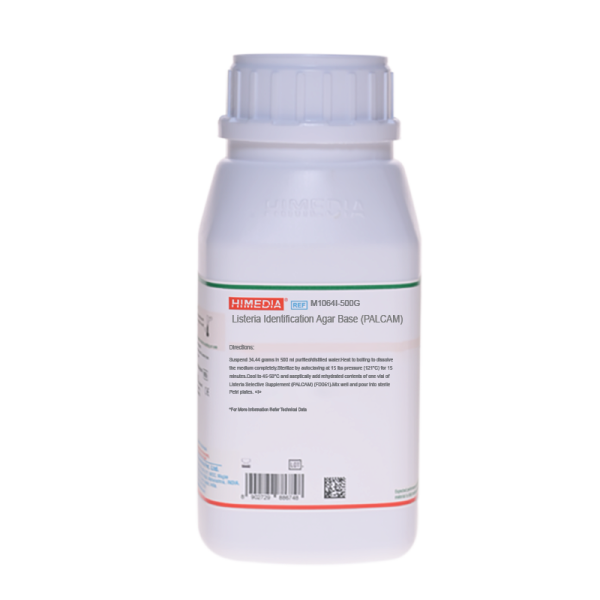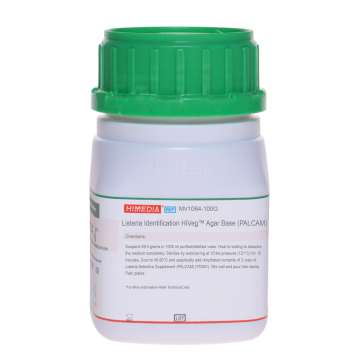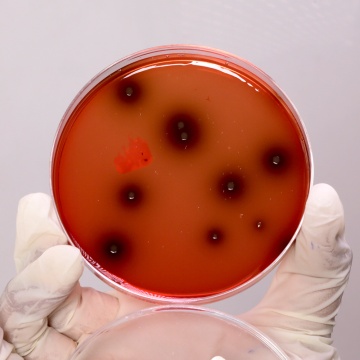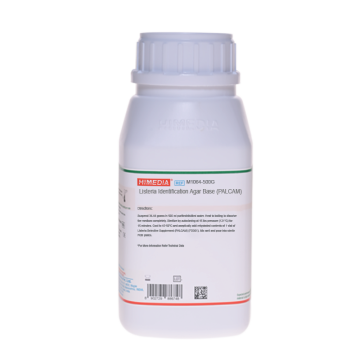 Your enquiry has been submitted
Your enquiry has been submitted
Listeria Identification Agar Base (PALCAM)
Intended use
Recommended for the detection and enumeration of Listeria monocytogenes from food and animal feeds. The composition and performance criteria of this medium are as per the specifications laid down in ISO 11290-2:1998.
Composition
M1064I-Listeria Identification Agar Base (PALCAM)
| Ingredients | g/L |
|---|---|
| Peptone, special | 23.000 |
| Corn starch | 1.000 |
| Sodium chloride | 5.000 |
| Yeast extract | 3.000 |
| D-Mannitol | 10.000 |
| Dextrose, anhydrous | 0.500 |
| Esculin | 0.800 |
| Ferric ammonium citrate | 0.500 |
| Lithium chloride | 15.000 |
| Phenol red | 0.080 |
| Agar | 10.000 |
Final pH (at 25°C): 7.2±0.2
Formula adjusted, standardized to suit performance parameters
Supplements to be added after autoclaving
FD061-PALCAM Selective Supplement
| Ingredients | Concentration |
|---|---|
| Polymyxin B sulphate | 5000IU |
| Ceftazidime | 10mg |
| Acriflavine hydrochloride | 2.500mg |
Directions
Suspend 34.44 grams in 500 ml purified / distilled water. Heat to boiling to dissolve the medium completely. Sterilize by autoclaving at 15 lbs pressure (121°C) for 15 minutes. Cool to 45-50°C and aseptically add rehydrated contents of 1 vial of PALCAM Selective Supplement (FD061). Mix well and pour into sterile Petri plates.
Principle And Interpretation
Listeria Identification Agar also known as Polymyxin Acriflavine Lithium Chloride Ceftazidime Esculin Mannitol (PALCAM) Agar was originally formulated by Van Netten et al (1). ISO Committee has recommended this medium with a slight modification for the detection and enumeration of Listeria monocytogenes from food and animal feeds (2). Peptone special and yeast extract provide nitrogenous and carbonaceous compounds, long chain amino acids, vitamin B complex and other essential growth nutrients. This is highly selective medium due to the presence of lithium chloride, acriflavine hydrochloride, ceftazidime and polymyxin B. This medium employs two indicator systems, esculin-ferric ammonium citrate and mannitol-phenol red. Listeria monocytogenes hydrolyzes esculin to esculetin and dextrose. Esculetin reacts with ferric ammonium citrate to form a brown-black complex seen as a black halo around colonies. Dextrose and starch serve as energy source. Contaminants such as Staphylococci ferment mannitol and is indicated by colour change from red to yellow rendering easy differentiation. Incubation in microaerophilic condition inhibits strict aerobes such as Bacillus and Pseudomonas species.
Depending upon the sample type, selective enrichment is done prior to inoculation onto PALCAM Agar. Generally Listeria Selective Enrichment Medium is used for dairy products while Listeria Selective Enrichment Medium UVM (M890), Fraser Secondary Enrichment Broth (M1083) are used for meat and poultry products. After 24 hours incubation Listeria species show grey-greenish or olive coloured, 1.5-2 mm diameter colonies with black halo, usually with black center. After 48 hours grey-green coloured, about 2 mm diameter colonies are observed with black halo and black sunken center.
Type of specimen
Food and dairy samples.
Specimen Collection and Handling
For food and dairy samples, follow appropriate techniques for sample collection and processing as per guidelines (2,3). After use, contaminated materials must be sterilized by autoclaving before discarding.
Warning and Precautions
Read the label before opening the container. Wear protective gloves/protective clothing/eye protection/ face protection. Follow good microbiological lab practices while handling specimens and culture. Standard precautions as per established guidelines should be followed while handling specimens. Safety guidelines may be referred in individual safety data sheets.
Limitations
- Further biochemical identification of organisms is required for confirmation.
Performance and Evaluation
Performance of the medium is expected when used as per the direction on the label within the expiry period when stored at recommended temperature.
Quality Control
Appearance: Light yellow to pink homogeneous free flowing powder
Gelling: Firm, comparable with 1.3% Agar gel.
Colour and Clarity of prepared Medium: Red coloured clear to slightly opalescent gel forms in Petri plates.
Reaction: Reaction of 6.9% w/v aqueous solution at 25°C. pH: 7.2±0.2
pH: 7.00-7.40
Cultural Response
Cultural characteristics observed under microaerophilic condition, with added PALCAM Selective Supplement (FD061), after an incubation at 35-37°C for 48 hours.
| Organism | Inoculum (CFU) | Growth | Recovery | Colony characteristics |
|---|---|---|---|---|
| Enterococcus faecalis ATCC 50-100 29212 (00087)* | none - poor | <=10% | grey colonies with a brown-green halo | |
| Enterococcus faecalis ATCC 50-100 19433 (00009)* | none - poor | <=10% | grey colonies with a brown-green halo | |
| Listeria monocytogenes ATCC 19111 (00020)* | 50-100 | good-luxuriant | >=50% | grey-green with black center and a black halo |
| Listeria monocytogenes ATCC 19117 | 50-100 | good-luxuriant | >=50% | grey-green with black center and a black halo |
| Listeria monocytogenes ATCC 19118 | 50-100 | good-luxuriant | >=50% | grey-green with black center and a black halo |
| Staphylococcus aureus subsp. aureus ATCC 25923 (00034)* | 50-100 | none - poor | <=10% | yellow colonies with yellow halo |
| Listeria monocytogenes ATCC 19112 | 50-100 | good-luxuriant | >=50% | grey-green with black center and a black halo |
| Listeria monocytogenes ATCC 13932 (00021)* | 50-100 | good-luxuriant | >=50% | grey-green with black center and a black halo |
| Listeria monocytogenes ATCC 35152 (00109)* | 50-100 | good-luxuriant | >=50% | grey-green with black center and a black halo |
| Listeria innocua ATCC 33090 (00017)* | 50-100 | good-luxuriant | >=50% | grey-green with black center and a black halo |
| Escherichia coli ATCC 2592250-100 (00013)* | none - poor | <=10% | ||
| Escherichia coli ATCC 8739 (00012)* | 50-100 | none - poor | <=10% |
Key: (*) - Corresponding WDCM numbers
Storage and Shelf Life
Store between 10-30°C in a tightly closed container and the prepared medium at 2-8°C. Use before expiry date on the label. On opening, product should be properly stored dry, after tightly capping the bottle in order to prevent lump formation due to the hygroscopic nature of the product. Improper storage of the product may lead to lump formation. Store in dry ventilated area protected from extremes of temperature and sources of ignition Seal the container tightly after use. Product performance is best if used within stated expiry period.
Disposal
User must ensure safe disposal by autoclaving and/or incineration of used or unusable preparations of this product. Follow established laboratory procedures in disposing of infectious materials and material that comes into contact with sample must be decontaminated and disposed of in accordance with current laboratory techniques (4,5).
Reference
- Van Netten P. et al, 1989, Int. J. Food Microbiol., 8(4):299.
- International Organisation for Standardization (ISO), ISO/DIS11290-2 : 2017. Microbiology of food and other animal feeding stuffs- Horizontal method for the detection and enumeration of L. monocytogenes and other Listeria species.
- Salfinger Y., and Tortorello M.L. Fifth (Ed.), 2015, Compendium of Methods for the Microbiological Examination of Foods, American Public Health Association, Washington, D.C.
- Isenberg, H.D. Clinical Microbiology Procedures Handbook 2nd Edition.
- Jorgensen, J.H., Pfaller, M.A., Carroll, K.C., Funke, G., Landry, M.L., Richter, S.S and Warnock., D.W. (2015) Manual of Clinical Microbiology, 11th Edition. Vol. 1.
| Product Name | Listeria Identification Agar Base (PALCAM) |
|---|---|
| SKU | M1064I |
| Product Type | Regular |
| Physical Form | Powder |
| Origin | Animal |
| Packaging type | HDPE |
| References | 1. Van Netten P., Peralse I, Van de Mosdik A., Curtis G.D.W., Mossel D. A.A., 1989, Int. J. Food Microbiol., 8(4):299. |
| Customized Product Available | No |









